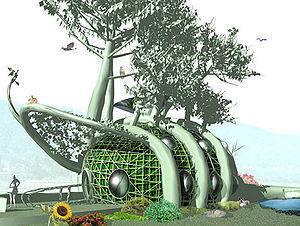
Fab Tree Hab
Encyclopedia

Mitchell Joachim
Mitchell Joachim is acknowledged as an innovator in ecological design, architecture, and urban design. He is also a researcher, and architectural educator...
, Javier Arbona and Lara Greden.
In departing from the modern sense of home construction, compilation of a budget for this prototype inherently opens the debate surrounding decision-making and green architecture. It is widely acknowledged that life cycle assessment
Life cycle assessment
A life-cycle assessment is a technique to assess environmental impacts associated with all the stages of a product's life from-cradle-to-grave A life-cycle assessment (LCA, also known as life-cycle analysis, ecobalance, and cradle-to-grave analysis) is a technique to assess environmental impacts...
methods would provide more favor to conscientious home designs by including energy cost savings and, more abstractly, accounting for reduction or elimination of externality costs. However, this falls short of recognizing the compound and continuous value of sustainable housing as an interweave of systems, and it still places too much value on benefits received today as opposed to tomorrow or hundred years from now. By rejecting the tendency towards immediacy and, likewise, first cost dependency, a true representation of sustainable value can be achieved by explicitly recognizing the adaptive, renewal, cooperative, evolutionary, and longevity characteristics of the home. This design explores the concepts in that debate by including all five traits. The use of computation enables these traits to become a construction method.
The method is to allow plants to grow over a computer-designed (CNC) removable plywood scaffold. Once the plants are interconnected and stable, the plywood is removed and reused. MIT is experimenting with woody plants that grow quickly and develop an interwoven root structure that's soft enough to "train" over the scaffold, but then hardens into a more durable structure. The inside walls would be conventional clay and plaster.
A methodology new to buildings yet ancient to gardening is introduced in this design - pleaching
Pleaching
Pleaching is a technique to weave the branches of trees into a hedge or to form a quincunx. Commonly, deciduous trees are planted in lines, then pleached to form a flat plane on clear stems above the ground level. Branches are woven together and lightly tied...
. Pleaching is a method of weaving together tree branches to form living archways, lattices, or screens. The trunks of inosculate, or self-grafting, trees, such as Elm, Live Oak, and Dogwood, are the load-bearing structure, and the branches form a continuous lattice frame for the walls and roof. Weaved along the exterior is a dense protective layer of vines, interspersed with soil pockets and growing plants. Using conventional computer designed scaffolds will vastly increase the control, depth, and accuracy of this building method.
The Fab Tree Hab is an experiment in time. Extra, or non-traditional, operating costs and required expertise over the life-time of the home include pest management with organic pesticides and maintenance of the living machine's water treatment system. Technical demonstration and innovation is still needed for certain components, primarily the bioplastic windows that accept growth of the structure and the management of flows across the wall section to assure that the interior remains dry and critter-free. All in all, the elapsed time to reach livability is greater than the traditional sense, but so should be the health and longevity of the home and family. Above all, the raising of this home can be achieved at a minimal price, requiring only some time to complete its structure. Realization of these homes will begin as an experiment, and it is envisioned that thereafter, the concept of renewal will take on a new architectural form - one of interdependency between nature and people.
See also
- ArborsculptureArborsculptureThe practice of training living trees and other woody plants into artistic shapes and useful structures is variously known as Pooktre, arborsculpture, tree training, tree shaping and by several alternative names...
- Autonomous buildingAutonomous buildingAn autonomous building is a building designed to be operated independently from infrastructural support services such as the electric power grid, gas grid, municipal water systems, sewage treatment systems, storm drains, communication services, and in some cases, public roads.Advocates of...
- Green architecture
- Green buildingGreen buildingGreen building refers to a structure and using process that is environmentally responsible and resource-efficient throughout a building's life-cycle: from siting to design, construction, operation, maintenance, renovation, and demolition...
- PleachingPleachingPleaching is a technique to weave the branches of trees into a hedge or to form a quincunx. Commonly, deciduous trees are planted in lines, then pleached to form a flat plane on clear stems above the ground level. Branches are woven together and lightly tied...
- Sustainable designSustainable designSustainable design is the philosophy of designing physical objects, the built environment, and services to comply with the principles of economic, social, and ecological sustainability.-Intentions:The intention of sustainable design is to "eliminate negative environmental...
- Terreform ONETerreform ONETerreform ONE is a 501c3 non-profit architecture and urban think tank that promotes ecological design in derelict municipal areas. By formulating unsolicited feasibility studies and egalitarian designs, the mission is to illustrate speculative environmental plans for New York City and other cities...
- Urban ecologyUrban ecologyUrban ecology is a subfield of ecology which deals with the interaction between organisms in an urban or urbanized community, and their interaction with that community. Urban ecologists study the trees, rivers, wildlife and open spaces found in cities to understand the extent of those resources and...

